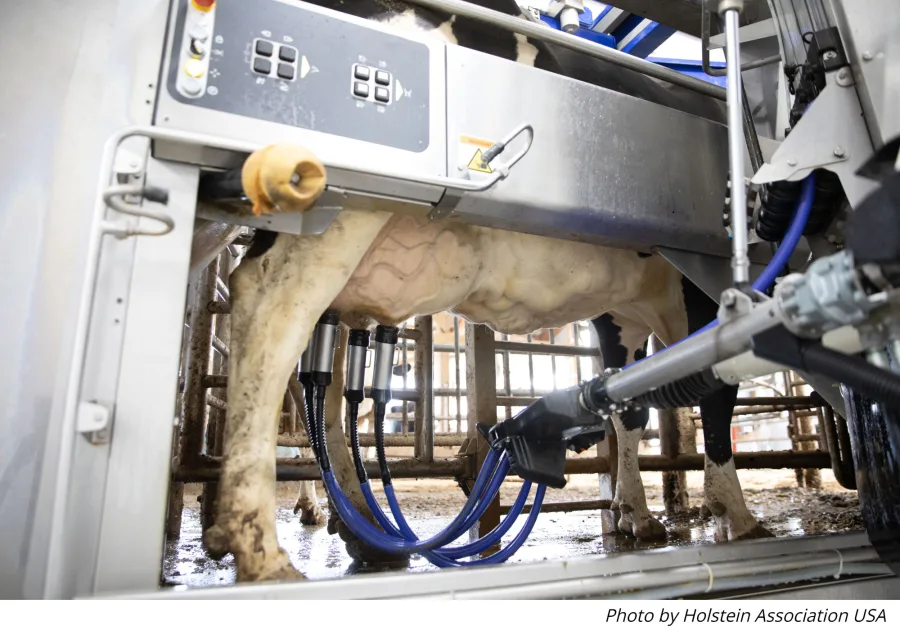Learn how the new 305-AA yield estimates affect dairy farming. Ready for changes in genetic evaluations and milk yield predictions?

Significant changes are coming for dairy farmers in the U.S. Starting mid-June, the old 305-ME (Mature Equivalent) yield estimate will be replaced by the new 305-AA (Average Age) standard. This isn’t just an update but a significant improvement reflecting modern dairy practices and environmental factors, providing better tools for herd management and breeding decisions.
Mark your calendars: On June 12, 305-AA yield estimates will debut in CDCB’s WebConnect data queries. By August 2024, they will be fully integrated into CDCB’s genetic evaluations. This change is based on extensive research and data analysis by USDA AGIL and CDCB, which examined over 100 million milk yield records.
The industry needs updated tools to make accurate, fair comparisons among cows. This transition and the new 305-AA are based on a 2023 USDA AGIL and CDCB study analyzing millions of milk yield records.
What does this mean for you? Moving to 305-AA aligns yield estimates with current insights on age, lactation length, climate, and other factors affecting milk production. This leads to more precise and fair comparisons among cows, helping optimize your herd’s performance.
Stay tuned as we dive deeper into the 305-AA transition, its impact on genetic evaluations, breed-specific changes, and what to expect moving forward.
The New Age of Yield Estimation: Introducing 305-AA
305-AA stands for 305-Average Age. It’s the new method for accurately comparing dairy cows of different ages, climates, and calving seasons. This tool estimates a cow’s lactation corrected to a standard age of 36 months using partial yield measurements from milk tests. It’s a robust update reflecting modern dairy practices.
A New Era in Dairy Production Efficiency
The shift from 305-ME to 305-AA is a game-changer for the dairy industry. For nearly 30 years, the 305-ME system couldn’t keep up with cow management and genetic advances. But now, the new 305-AA model brings us up to speed, leveraging recent insights into age, climate, and lactation variables for a more accurate milk yield estimate.
A 2023 study by USDA AGIL and CDCB, analyzing over 100 million milk yield records, showed how outdated the old system was. The new 305-AA promises better decision-making tools, boosting both productivity and fairness in the industry.
What 305-AA Means for Different Dairy Breeds
The transition to 305-AA will affect different dairy breeds in unique ways. Changes will be minimal for Holsteins, as their data heavily influenced the 1994 adjustments. This means Holstein farmers won’t see minor shifts in their yield estimates or genetic evaluations.
Non-Holstein breeds will see more significant updates due to more precise, breed-specific adjustments. Ayrshires will experience stable PTAs with a slight increase in milk, fat, and protein yields, especially for younger males. Brown Swiss will see slightly higher overall yield PTAs for younger cows, with older animals maintaining stability.
Guernseys will find that younger males show an increase, while older cows might see a slight decline in their milk, fat, and protein PTAs. Jersey cows will have a noticeable decrease in yield PTAs for younger males, but older males will benefit from an increase in their evaluations.
This recalibration means that farmers focusing on non-Holstein breeds can expect more tailored and accurate yield estimates. These changes pave the way for better breed management and selection strategies in the future.
The Ripple Effects of 305-AA on Breed-Specific PTAs
The shift to 305-AA adjustments will have varied impacts on Predicted Transmitting Abilities (PTAs) across different dairy breeds. Each breed will experience unique changes for more breed-specific and accurate assessments.
Ayrshire: PTAs will stay stable, with younger males seeing a slight increase in milk, fat, and protein yields.
Brown Swiss: Young animals will see a slight increase in yield PTAs, while older animals remain stable.
Guernsey: Younger males will experience an increase in milk, fat, and protein PTAs, while older males may see a decrease.
Holstein: Young males will get a boost in yield PTAs, and older animals will have more stable measurements.
Jersey: Younger males will see a decrease in yield PTAs, while older males will experience an increase.
Coming Soon: 305-AA Data Goes Live on CDCB WebConnect and Genetic Evaluations.
Starting June 12, 2024, you’ll see the new 305-AA yield estimates in CDCB’s WebConnect queries. This kicks off the move to 305-AA.
By August 2024, 305-AA will be fully integrated into CDCB genetic evaluations. Phenotypic updates in the triannual evaluations will adopt the new method, affecting PTAs and indices like Net Merit $.
Rest Easy: July Evaluations to Continue Uninterrupted; August Brings Enhanced Accuracy with 305-AA
Rest easy; switching to 305-AA won’t affect July’s monthly evaluations. Your data will still follow the old 305-ME adjustments for now. However, with the triannual update from August 13, 2024, all evaluations will feature the new 305-AA data, giving you the most accurate yield estimates for your dairy herd.
The Bottom Line
The switch to 305-AA is a big step forward. It uses the latest research and a massive database for more accurate milk yield estimates. This change reflects how dairy management and cow biology have evolved over the last 30 years. With 305-AA, comparing cows—no matter their age, breed, or conditions—is now fairer and more scientific.
Key Takeaways:
The transition from 305-ME to 305-AA is set to bring significant advancements in yield estimation for U.S. dairy farmers. Here are some key takeaways:
- Effective date: 305-AA will be officially implemented starting June 12.
- Modern alignment: This change reflects current management practices and environmental factors.
- Updated research: Based on a 2023 study examining over 100 million milk yield records.
- Breed-specific adjustments: Non-Holstein breeds will see more significant changes due to more precise data.
- Impact on PTAs: Different breeds will experience unique effects on their Predicted Transmitting Abilities (PTAs).
- Genetic evaluations: The 305-AA adjustments will appear in CDCB genetic evaluations starting August 2024.
- Uninterrupted evaluations: The July monthly evaluations will not be affected by this change.











